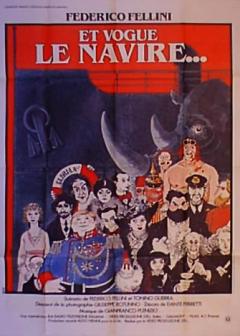











And the Ship Sails On
The film opens with the liner “Gloria N.” ready to sail from Naples Harbor in July 1914. Orlando, an Italian journalist, tells viewers that the cruise is a funeral voyage to scatter opera singer Edmea Tetua’s ashes near the island of Erimo, her birthplace. Tetua – who is considered the greatest singer of all times - is celebrated for her goddess-like voice. The bumbling but lovable journalist entertains the passengers, who are mostly opera singers, conductors and Edmea’s fans. A jealous and bitter soprano named Ildebranda desperately tries to penetrate the secret behind Edmea Tetua’s unforgettable voice. An awful stench rises from the ship’s hold and soon it turns out that a love-sick rhino has been neglected by the ship’s crew. The beast is pulled up, washed on deck, and returned to the hold with fresh water and hay. Then the passengers discover a crowd of shipwrecked Serbians camped on the deck of the ship. Fleeing in rafts after the Sarajevo assassination, the refugees were taken on board by the captain the previous night. Edmea Tetua’s ashes are scattered near Erimo and the refugees board a lifeboat after the ceremony. A young Serb hurls a bomb at an Austro-Hungarian ship. The Austrian soldiers bombard the “Gloria N.” ship, that sinks while the Austro-Hungarian ship explodes and sinks. Orlando is on board a lifeboat while the rhino ruminates happily.
Crew
Cast
Awards
Peculiarites
Reviews
- strict warning: Only variables should be passed by reference in /home/fellini/domains/federicofellini.it/public_html/sites/all/modules/date/date_api.module on line 866.
- strict warning: Only variables should be passed by reference in /home/fellini/domains/federicofellini.it/public_html/sites/all/modules/date/date_api.module on line 866.
- strict warning: Non-static method view::load() should not be called statically in /home/fellini/domains/federicofellini.it/public_html/sites/all/modules/views/views.module on line 906.
- strict warning: Declaration of views_handler_argument::init() should be compatible with views_handler::init(&$view, $options) in /home/fellini/domains/federicofellini.it/public_html/sites/all/modules/views/handlers/views_handler_argument.inc on line 744.
- strict warning: Declaration of semanticviews_plugin_style_default::options() should be compatible with views_object::options() in /home/fellini/domains/federicofellini.it/public_html/sites/all/modules/semanticviews/semanticviews_plugin_style_default.inc on line 232.
- strict warning: Declaration of views_plugin_row::options_validate() should be compatible with views_plugin::options_validate(&$form, &$form_state) in /home/fellini/domains/federicofellini.it/public_html/sites/all/modules/views/plugins/views_plugin_row.inc on line 134.
- strict warning: Declaration of views_plugin_row::options_submit() should be compatible with views_plugin::options_submit(&$form, &$form_state) in /home/fellini/domains/federicofellini.it/public_html/sites/all/modules/views/plugins/views_plugin_row.inc on line 134.
- strict warning: Declaration of semanticviews_plugin_row_fields::options_validate() should be compatible with views_plugin_row::options_validate($form, &$form_state) in /home/fellini/domains/federicofellini.it/public_html/sites/all/modules/semanticviews/semanticviews_plugin_row_fields.inc on line 117.
- strict warning: Non-static method view::load() should not be called statically in /home/fellini/domains/federicofellini.it/public_html/sites/all/modules/views/views.module on line 906.
- strict warning: Declaration of views_handler_filter::options_validate() should be compatible with views_handler::options_validate($form, &$form_state) in /home/fellini/domains/federicofellini.it/public_html/sites/all/modules/views/handlers/views_handler_filter.inc on line 607.
- strict warning: Declaration of views_handler_filter::options_submit() should be compatible with views_handler::options_submit($form, &$form_state) in /home/fellini/domains/federicofellini.it/public_html/sites/all/modules/views/handlers/views_handler_filter.inc on line 607.

